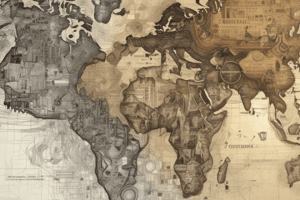Podcast
Questions and Answers
What is the main objective of the GP technique in police investigations?
What is the main objective of the GP technique in police investigations?
- To identify the criminal's place of residence (correct)
- To optimize patrol zones
- To track possible suspects through police databases
- To analyze the criminal's decision-making process
How does the GP technique help the police in tracking possible suspects?
How does the GP technique help the police in tracking possible suspects?
- By optimizing patrol zones and search strategies
- By identifying the criminal action zone
- By georeferencing crime scenes
- By analyzing the criminal's decision-making at a spatial and temporal level (correct)
What type of information does a Geographic Profile (PG) typically offer?
What type of information does a Geographic Profile (PG) typically offer?
- Information on the criminal's family background and social connections
- Information on the criminal's area of action, movement characteristics, temporal-spatial patterns, and potential residence (correct)
- Information on the criminal's psychological profile and educational background
- Information on the criminal's financial activities and hobbies
What is meant by the 'anchor point' in geographic profiling?
What is meant by the 'anchor point' in geographic profiling?
What type of data is often presented in maps within Geographic Profiles?
What type of data is often presented in maps within Geographic Profiles?
Which theory heavily influences the theoretical bases of Geographic Profiling (PG)?
Which theory heavily influences the theoretical bases of Geographic Profiling (PG)?
In what way does the GP technique contribute to police investigations regarding patrol zones?
In what way does the GP technique contribute to police investigations regarding patrol zones?
According to studies mentioned in the text, what is a common behavior observed among criminals when committing crimes?
According to studies mentioned in the text, what is a common behavior observed among criminals when committing crimes?
What kind of information can Geographic Profiling provide to assist the police in tracking possible suspects?
What kind of information can Geographic Profiling provide to assist the police in tracking possible suspects?
What specific finding about sex offenders' behavior is highlighted by various studies mentioned in the text?
What specific finding about sex offenders' behavior is highlighted by various studies mentioned in the text?
What does consistency, as mentioned in the text, refer to in criminal behavior?
What does consistency, as mentioned in the text, refer to in criminal behavior?
How does analyzing geographical behavior help in criminal profiling?
How does analyzing geographical behavior help in criminal profiling?
What role do Geographic Information Systems (GIS) play in criminal profiling?
What role do Geographic Information Systems (GIS) play in criminal profiling?
How do quantitative variables like distance and time aid in criminal profiling?
How do quantitative variables like distance and time aid in criminal profiling?
Why is studying a criminal's geographical behavior important in investigations?
Why is studying a criminal's geographical behavior important in investigations?
What does the situationist tradition of Psychology suggest about human behavior?
What does the situationist tradition of Psychology suggest about human behavior?
How does an individual usually choose their places of leisure according to the text?
How does an individual usually choose their places of leisure according to the text?
What is the significance of an offender's ability to adapt to the scene of a crime?
What is the significance of an offender's ability to adapt to the scene of a crime?
What does Modus Operandi (MO) refer to in the context of criminal behavior?
What does Modus Operandi (MO) refer to in the context of criminal behavior?
How do individuals typically select places for criminal activities when they cannot choose according to the text?
How do individuals typically select places for criminal activities when they cannot choose according to the text?
What does the signature of a criminal reveal?
What does the signature of a criminal reveal?
In geographic behavior, what do high-risk MO behaviors typically exhibit?
In geographic behavior, what do high-risk MO behaviors typically exhibit?
What distinguishes the MO from the signature in criminal behavior analysis?
What distinguishes the MO from the signature in criminal behavior analysis?
Why might selecting unknown victims be considered a low-risk MO behavior?
Why might selecting unknown victims be considered a low-risk MO behavior?
What indicates a high-risk MO behavior according to geographic behavior analysis?
What indicates a high-risk MO behavior according to geographic behavior analysis?
What is the main difference between 'ritual' behaviors and MO behaviors?
What is the main difference between 'ritual' behaviors and MO behaviors?
What do ritual behaviors in violent homicides often indicate?
What do ritual behaviors in violent homicides often indicate?
In serial crimes, how does the core ritual behavior of the offender typically evolve over time?
In serial crimes, how does the core ritual behavior of the offender typically evolve over time?
What misconception about repeating a behavior in different crimes is corrected in the text?
What misconception about repeating a behavior in different crimes is corrected in the text?
How are ritual behaviors typically represented in the cinematographic world?
How are ritual behaviors typically represented in the cinematographic world?
What is the crime scene in forensic profiling?
What is the crime scene in forensic profiling?
How does the crime scene help in forensic profiling?
How does the crime scene help in forensic profiling?
What does geographic behavior refer to in forensic profiling?
What does geographic behavior refer to in forensic profiling?
Why is the crime scene considered a non-neutral element in forensic profiling?
Why is the crime scene considered a non-neutral element in forensic profiling?
What role does the crime scene play in making a crime compatible with its context?
What role does the crime scene play in making a crime compatible with its context?
In forensic profiling, what is the importance of understanding the geographic behavior of a criminal?
In forensic profiling, what is the importance of understanding the geographic behavior of a criminal?
How does geographic behavior aid profilers in identifying a criminal's characteristics?
How does geographic behavior aid profilers in identifying a criminal's characteristics?
What can be inferred about a criminal by analyzing their geographic behavior?
What can be inferred about a criminal by analyzing their geographic behavior?
'Geographic behavior' in forensic profiling pertains to:
'Geographic behavior' in forensic profiling pertains to:
In forensic profiling, what does the term 'victimology' refer to?
In forensic profiling, what does the term 'victimology' refer to?
Flashcards are hidden until you start studying
Study Notes
Geographic Profiling (GP)
- The majority of sexual aggressors commit their crimes in a nearby area, making it easier for the police to develop police persecution techniques and strategies, including the GP.
- The GP is a technique for analyzing the geographic behavior developed by the criminal and his decision-making at a spatial and temporal level in order to advise police investigators.
- The main objective of GP is to identify a geographical area with a high probability that the offender's base of operations is located within it, which is called the anchor point.
Anchor Point
- The anchor point is usually the offender's residence, but it can also be his place of work, a friend's house, or a relative's, among others.
- This information about the probable place of residence can help the police to track possible suspects in the area through police databases.
Criminal Action Zone
- The GP can also provide the identification of the criminal action zone, an area where there is a greater probability that he will look for new victims and act again.
- The police can optimize patrol zones and search strategies in a specific area of the city based on this information.
Geographic Profiling Software
- The GP has led to the development of a sub-discipline within criminological profiling and the creation of specific geographic profiling software.
- This software tries to offer information on the criminal's area of action, their movement characteristics, temporal-spatial patterns, and, at best, information about where the offender may reside.
Theoretical Bases
- The theoretical bases of the GP arise mainly from the contributions of Environmental Criminology and various lines of research such as the Journey to Crime.
- These studies have shown that criminals tend to move very little to commit their crimes and that sex offenders tend to act mostly very close to where they live.
Consistency and Ritual
- The consistency of criminal behavior suggests that the criminal behaves with his victim in the same way as he behaves with other people in his non-criminal life.
- The ritual will also allow us to outline motivational and psychological aspects of the perpetrator of the crime, which can help investigators filter or search for suspects.
Geographical Behavior
- The crime takes place in a specific space, a place with a series of characteristics and conditions with which the criminal must interact and that force him to make a series of decisions and perform certain behaviors.
- The use of Geographic Information Systems (GIS) and certain mathematical algorithms can help to carry out calculations and predictive models regarding the mobility and geographical activity of a criminal.
Modus Operandi (MO)
- The MO is the way in which a crime has been committed, including the actions and behaviors aimed at committing the crime.
- The MO can be categorized as low-risk or high-risk, depending on the level of planning and skill involved.
Signature
- The signature of the criminal can be defined as those behaviors that tell us about the final motivation to commit the crime, revealing the psychological or emotional needs that the criminal intends to cover by committing his crimes.
- The signature is more static than MO behaviors and is maintained even if the MO changes.
Crime Scene
- The crime scene is the space where the crime takes place and where the victim and perpetrator interact.
- The crime scene is the only element that remains, allowing us to reconstruct the crime in the same context in which it happened and recreate the behavior displayed by the criminal.
Studying That Suits You
Use AI to generate personalized quizzes and flashcards to suit your learning preferences.




